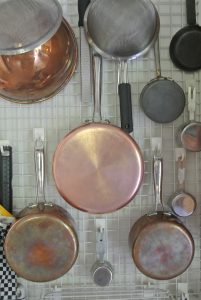Dinner time in Cleveland Heights was always a well-orchestrated event. Ma had dinner well in process by the time Dad arrived. My sister and I set the table. After dinner, while my mother wrangled my brother into bath and bed, my father washed the dishes, which is to say he washed and P and I dried and put away.
My folks had received a set of Revere Ware as a wedding gift. Good pots, high quality. But those copper bottoms (the main reason the pots had such good heat distribution) quickly got dark, discolored. Not the verdigris of a church dome sheathed in copper but a kind of oil-slick patina. When Dad got out the Penny Brite and scrubbed away, the bottom gleamed.
That pinky-gold glow of the copper delighted me. The pot looked both new and special, and I fully understood that it would produce foods of exquisite flavor and textures to make the palate swoon.
But what I enjoyed was that moment with my father, the sleeves of his white shirt rolled up, the sense of participating in a ritual in which every member had a part to play—even if we complained about the part we were assigned.
Does polishing the copper affect the functionality of the pot? One manufacturer says this:
When copper is heated up, its colour changes to different shades. Over time, copper cookware develops a patina. This is a completely natural process and does not have an adverse effect
on the food that is prepared in copper pots and copper pans.
Most copper pots one might acquire today are lined with stainless steel. The copper on the outside transfers the heat evenly, reducing hot spots and making food heat more quickly. Stainless steel on the inside provides a nonreactive surface and makes cleanup easy.
We’ve acquired our copper pans pretty much one at a time, finding them deeply discounted at Marshall’s department store. I like using them. The frying pan is the only thing that works well when I need to make caramel, and I can’t make a flan without caramel. The saucepans cook vegetables well, are perfect for hot cereal in the morning and reduce sauces pretty much as one would want them reduced.
I hang them on the rack and don’t often shine them up, but when I get out the Penny Brite they look dramatic, rather Julia Child-esque, as they reflect sunshine and fill that corner with warmth.
And that’s the thing, isn’t it? Warmth?
We weren’t a model family. Far from it. Discipline was unpredictable, expectations were fuzzy, supervision was spotty. But the thing I felt always was that dependable warmth, the sardonic humor in my father’s eyes, the distracted way my mother pulled me close and twiddled with my hair while she chatted with a neighbor.
But my dad made the bottoms of those Revere pots gleam like a new penny and my sister and I gave them an extra swipe with the dishcloth before returning them to the cupboard.
And when I look into the shine of my discounted pans when I have scrubbed them into brightness and buffed them to a high-gloss dry, I see my father smiling back at me.

